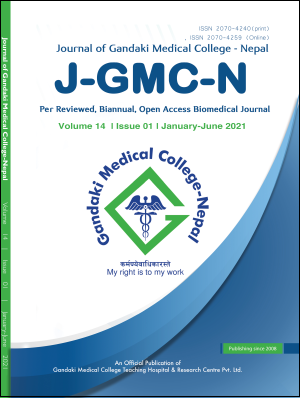Bacteriological profile of surgical site infections in a tertiary care hospital of western Nepal
DOI:
https://doi.org/10.3126/jgmcn.v14i1.32703Keywords:
Antibiotic resistance, Escherichia coli, Nosocomial infections, Staphylococcus aureus, surgical site infectionsAbstract
Introduction: Surgical site infections are one of the most commonly reported nosocomial infections resulting into significant morbidity and mortality. Hospital admission and surgical procedures increase the risk of infection with multidrug resistant pathogens. This study was aimed to determine the bacterial agents associated with surgical site infections and antibiotic resistance patterns of the isolates.
Methods: A total of 161 specimens from patients with surgical site infections were included in this study. Isolation, identification and antibiotic susceptibility testing of the isolates was performed by standard microbiological techniques.
Results: Out of 161 samples, 94 bacterial isolates were recovered. Gram positive bacteria were isolated in 57.4% (54/94) cases and Staphylococcus aureus was the most common organism (49/54) with 65.3% (32/49) methicillin resistant Staphylococcus aureus isolates. All S. aureus isolates were susceptible to vancomycin. Gram negative bacteria constituted 42.6% (40/94) of total isolates and Escherichia coli was the commonest organism (13/40). Majority of Gram negative isolates were susceptible to amikacin, imipenem and piperacillin-tazobactam. Resistance to imipenem was detected among isolates of E coli, Pseudomonas and Acinetobacter species.
Conclusion: Gram positive isolates were more commonly associated with surgical site infections. High percentage of MRSA was detected among the S. aureus isolates but no vancomycin resistant S. aureus. High percentage of Gram negative isolates was susceptible to imipenem, piperacillin-tazobactam, amikacin and gentimicin.
Downloads
Downloads
Published
How to Cite
Issue
Section
License
This license allows reusers to distribute, remix, adapt, and build upon the material in any medium or format for noncommercial purposes only, and only so long as attribution is given to the creator.




